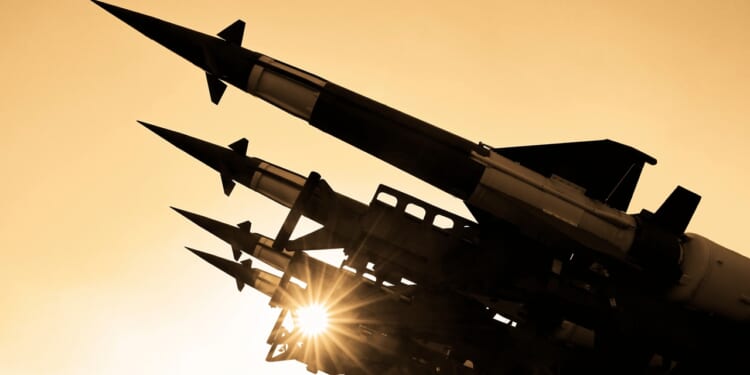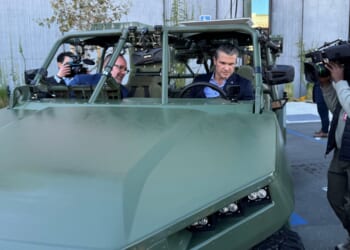Ukraine’s interception rate for ballistic missiles, which stood at an impressive 37 percent in August, was slashed in the month of September to just 6 percent.
The Ukraine War has taken unpredictable, and at times shocking, directions the longer it has raged. A recent Financial Times report indicates that the Russian Armed Forces may have figured out a loophole in Ukraine’s otherwise-reliable missile defenses.
Russia’s Missiles Now Come With Evasive Maneuvers
According to the report, Russia has upgraded their Iskander-M and Kinzhal ballistic missiles to better bypass US-supplied Patriot air defense systems in Ukraine. These changes include trajectory alterations that confuse interceptors, making it harder for Ukraine to knock them out of the sky.
This has been observed in recent attacks on Ukrainian drone production facilities.
These modifications by Russia represent a true gamechanger, exacerbating Ukraine’s challenges amid slow US deliveries of replacement interceptors. Undoubtedly, this will lead to more successful Russian strikes on critical infrastructure.
Here’s the kicker, though. Ukraine’s interception rate for ballistic missiles, which stood at an impressive 37 percent in August, was slashed in the month of September to just 6 percent. According to the Center for Information Resilience, cited in the Financial Times piece, fewer missiles were launched by Russia at key targets in Ukraine, but the success rates of those Russian missiles improved drastically, as those percentages highlight. The developments demonstrated in the Financial Times report undercut the often-rosy claims of success against the Kremlin by Ukrainian, European, and some American officials.
These developments are just a microcosm of how seriously the war has turned in Russia’s favor at the tactical level—and, if trends persist, how Russia will come to dominate at the all-important strategic level.
How Will the West React to the Collapse of Ukraine’s Air Defenses?
News broke last week that the Trump administration, in a reversal of its previous statements, now intends to supply Ukraine with targeting intelligence to enable long-range missile attacks on Russia’s energy infrastructure, such as refineries and power plants—aiming to cut off Kremlin revenue streams.
This is all coming amidst Kyiv’s pleas for more advanced weaponry. I have been told on background that, throughout the course of the war, US targeting analysts have been used at key points to augment Ukraine’s chances at striking key Russian strategic targets. Of course, this has never been officially confirmed either by the Biden or Trump administrations. But there is an abundance of circumstantial evidence to suggest it.
Regardless, the Americans are now acknowledging publicly that, henceforth, their targeting intelligence will be used to directly target strategic Russian energy sources. This is connected to President Donald Trump’s recent utterances about possibly supplying America’s iconic Tomahawk cruise missiles for use inside Russia.
While this represents a verbal escalation, it also betrays a reality that Washington, London, and Brussels have striven to ignore: the Russians are winning. And not even NATO’s vaunted military assistance, which has been constantly escalating since the start of Russia’s invasion in 2022, is enough to stop the advance by the Russkies.
The Europeans, who have made a big show of wanting to increase their military spending, are largely incapable of picking up the proverbial slack from the Americans. As an example, the European Union’s leadership failed to advance a loan proposal based on frozen Russian assets. EU leaders refused to progress on a proposed €140 billion loan to Ukraine, which would have been funded by profits from immobilized Russian assets held in Europe. It was opposition from Belgium as well as from Luxembourg, and France—the same French government that has ostensibly been zealously pro-Ukraine since the very beginning—that stopped the proposal from going forward.
Of course, this caution will have been proven wise because coopting a nuclear power’s assets is one of the worst ideas put forward to date. But the delay is a stark reminder of how unserious Europe’s policy toward Russia and the Ukraine War has been. On the one hand, European leaders refuse to countenance diplomacy with Moscow. Yet, they are utterly incapable—despite Europe having nearly 20 times Russia’s GDP—to reliably fund their own defense, or even agree on punitive financial measures directed against their great bogeyman to the East.
Adaptation Is Key in Modern Warfare
The art of warfare, especially protracted warfare of the kind that has defined the Ukraine War, is twofold. First, it is all about which side can hold their respective lines with minimal breakage in those lines.
Second, even more importantly, modern wars are determined by the side that adapts to the enemy’s tactics and technology the fastest. Ukraine had enjoyed some key adaptations that allowed them to at least keep pace with the Russians in the first half of the war. The last several months have seen a decisive shift, however, in Russia’s favor.
Not only have the Russians engaged in a brutal and methodical—albeit slogging—campaign against Ukraine, but now Russian technology has adapted to Ukraine’s last line of air defenses.
American and European leaders should be advocating for a peace deal, not bleating about how they can fight to the last Ukrainian. There are far fewer of them available than what either Brussels or Washington realizes. And the are running out of capabilities to continue holding the line against the Russians.
About the Author: Brandon J. Weichert
Brandon J. Weichert is a senior national security editor at The National Interest. Recently, Weichert became the host of The National Security Hour on America Outloud News and iHeartRadio, where he discusses national security policy every Wednesday at 8pm Eastern. He is also a contributor at Popular Mechanics and has consulted regularly with various government institutions and private organizations on geopolitical issues. Weichert’s writings have appeared in multiple publications, including The Washington Times, National Review, The American Spectator, MSN, The Asia Times, and others. His books include Winning Space: How America Remains a Superpower, Biohacked: China’s Race to Control Life, and The Shadow War: Iran’s Quest for Supremacy. His newest book, A Disaster of Our Own Making: How the West Lost Ukraine is available for purchase wherever books are sold. He can be followed via Twitter @WeTheBrandon.
Image: Shutterstock / maradon 333.

















